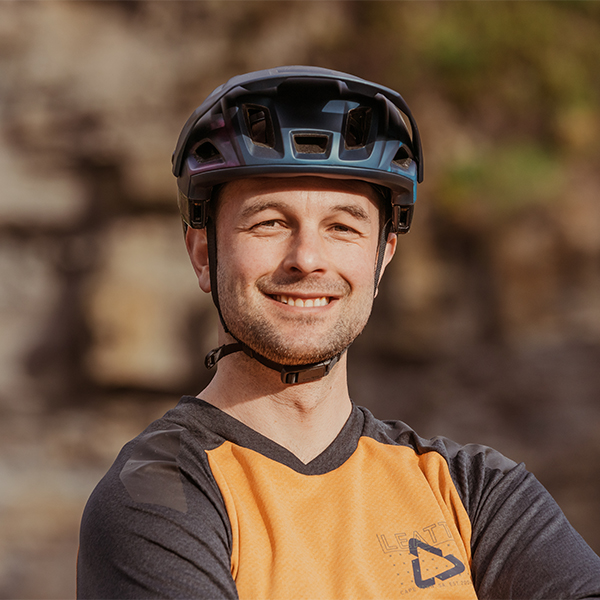If you’ve never been mountain biking at night, you’re missing out. It presents an awesome challenge; obstacles come at you faster, it feels like you’re riding at warp speed and there’s something majestic about being in the woods at night.
A high-powered front light is essential to illuminate the trail ahead and the brighter your lights are, the better your night-riding experience is going to be.
You’ll be able to see more of the trail, obstacles shrouded in the shadows pop out at you and speed comes naturally.
We've tested more than 500 lights in the past 17 years, illuminating forests with a variety of options and always considering brightness, battery life, beam pattern, practicality and value for money.
Following our latest group test, we've compiled this list of our favourite high-powered mountain bike lights.
Below that, we've detailed what you should look for when buying a mountain bike light in our buyer's guide, which you can skip to.
If you're looking for front and rear lights for road cycling and commuting, check out our guide to the best bike lights.
SQUIRREL_PLAYLIST_10125780
Editor's note: we updated our best mountain bike lights list on 5 November 2025 with our latest high-scoring reviews, including the Exposure Diablo 15, Lezyne Mega Drive 2400+, Cat Eye AMPP 2200 and Knog Blinder X 2300. We have also given awards to the best lights in their categories and added information on how we test lights.
Best mountain bike lights at a glance
Best overall: Magicshine Monteer 8000S Galaxy V2.0

The Galaxy light delivers an incredible 8,000 lumens for superb trail visibility. With Bluetooth remote control, 30 modes, and impressive beam quality, it outperforms most of its rivals. Runtimes range from 1.5 to 32 hours; only a mode and battery indicator is missing.
- Read more: Magicshine Monteer 8000S Galaxy V2.0 review
SQUIRREL_TEXT_13097762
Best in class: Magicshine Monteer 12000

The Monteer 12000 delivers unmatched 12,000-lumen power with a wide, balanced beam that boosts confidence and visibility. Its durable, IPX6-rated build, adjustable mount, and over two-hour runtime impress, while charge indicators and multiple modes enhance usability and battery management.
- Read more: Magicshine Monteer 12000 review
SQUIRREL_TEXT_13076538
Best budget: Blackburn Countdown 1600

Despite its 1,600-lumen claim, this compact IP67-rated light feels brighter, offering strong throw and depth for fast trails. However, the limited spread hinders tight turns. Its sturdy mount fits well, but the plastic clamp is tricky to tighten, although space-efficient.
- Read more: Blackburn Countdown 1600 review
SQUIRREL_TEXT_13077296
Best mountain bike lights in depth
Exposure MaXx-D MK15
SQUIRREL_TEXT_13076582

- £450 / $550 / €530 as tested
- Pros: Incredible beam hue; good beam pattern; sturdy construction
- Cons: Cost
Class-leading illumination, top-quality construction and clever tech make this all-in-one light well worth its high price tag.
The Reflex++ mode senses movement, adjusting power output to the difficulty of the trail. Stop riding, or cruise along a smooth section of trail, and the light dims slowly so your eyes can adjust.
Wiggle the bar or hit a bump and it switches to full power instantly. This works so well, it renders manual modes pointless, so you can have an entirely hands-off experience.
There’s more than enough power to light up the most technical trails and it’s evenly spread with a gradual fade that provides incredible context. Plenty of light is projected downwards, with a beautiful hue.
In 2,700-lumen Reflex++ mode, the runtime is a generous three hours. The aluminium unit is IP65-rated and has a two-year warranty; the LEDs are guaranteed for life.
- Read more: full Exposure MaXx-D MK15 review
Specs
Max lumens: 4,600 | Runtime (max power): 2 hours | Modes: 10 | Weight: 353g
SQUIRREL_13076582
Magicshine Monteer 8000S Galaxy V2.0
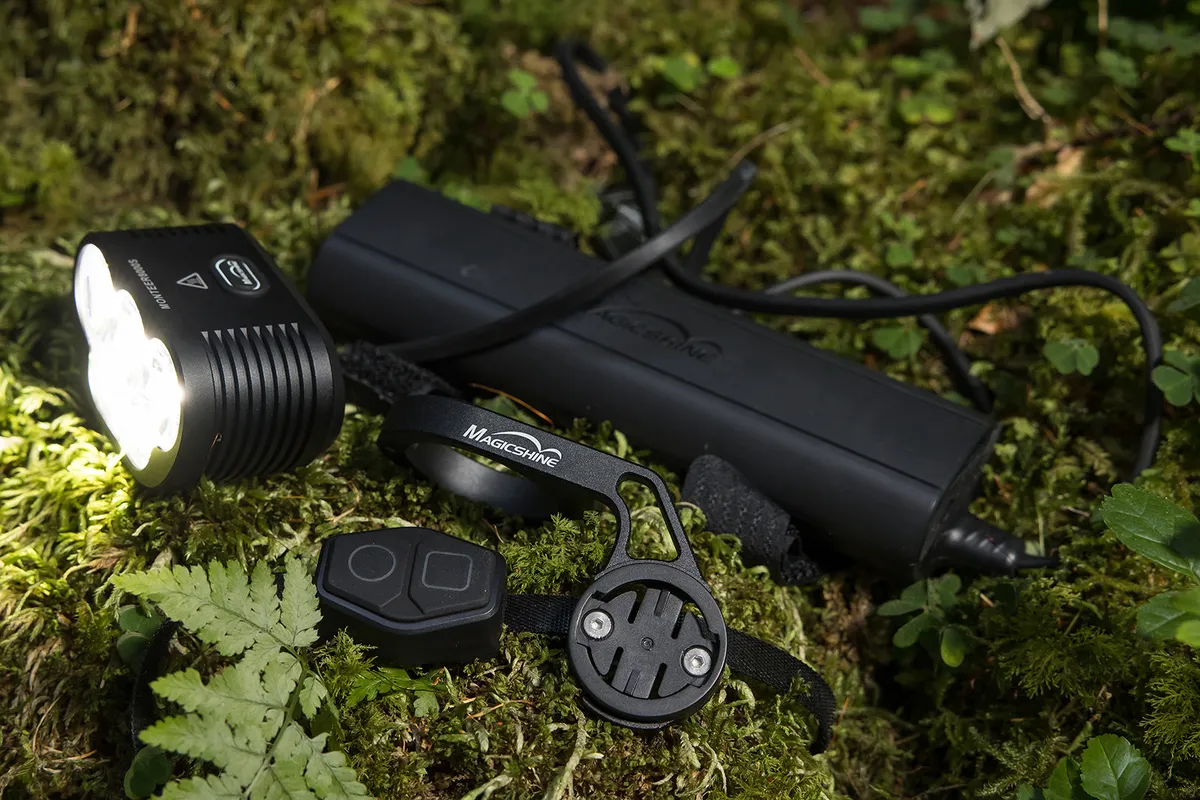
- £340 / $410 as tested
- Pros: Immense power for technical trail riding
- Cons: Runtime; battery and mode indicators would be a great bonus
Boasting a brain-bending 8,000 lumens, the Galaxy’s immense brightness is second to none. It lights up the trail and its surroundings with fantastic competence, making it a one-stop-shop for gnarly trail riding.
Magicshine has updated this light over the original with the addition of software and hardware needed for the Bluetooth wireless remote control.
There are 30 modes, with claimed runtimes starting at 32 hours for the 400-lumen setting and dropping to one hour 30 minutes for the 8,000-lumen max-power mode, although it ran for slightly longer in testing.
There are no bleached spots of light on the trails and the impressive beam pattern is broad and well-controlled.
The addition of a mode or battery indicator would be an area for the brand to explore in a future iteration, otherwise it's top marks.
The V2.0's predecessor, the MagicShine Monteer 8000S Galaxy, also scored a full five stars last year and is worth consideration.
- Read more: Magicshine Monteer 8000S Galaxy V2.0 review
- Buy now from Magicshine
Specs
Max lumens: 8,000 | Runtime (max power): 1 hour 38 minutes | Modes: 30 | Weight: 623g
SQUIRREL_13097762
Magicshine Monteer 12000
SQUIRREL_TEXT_13076538
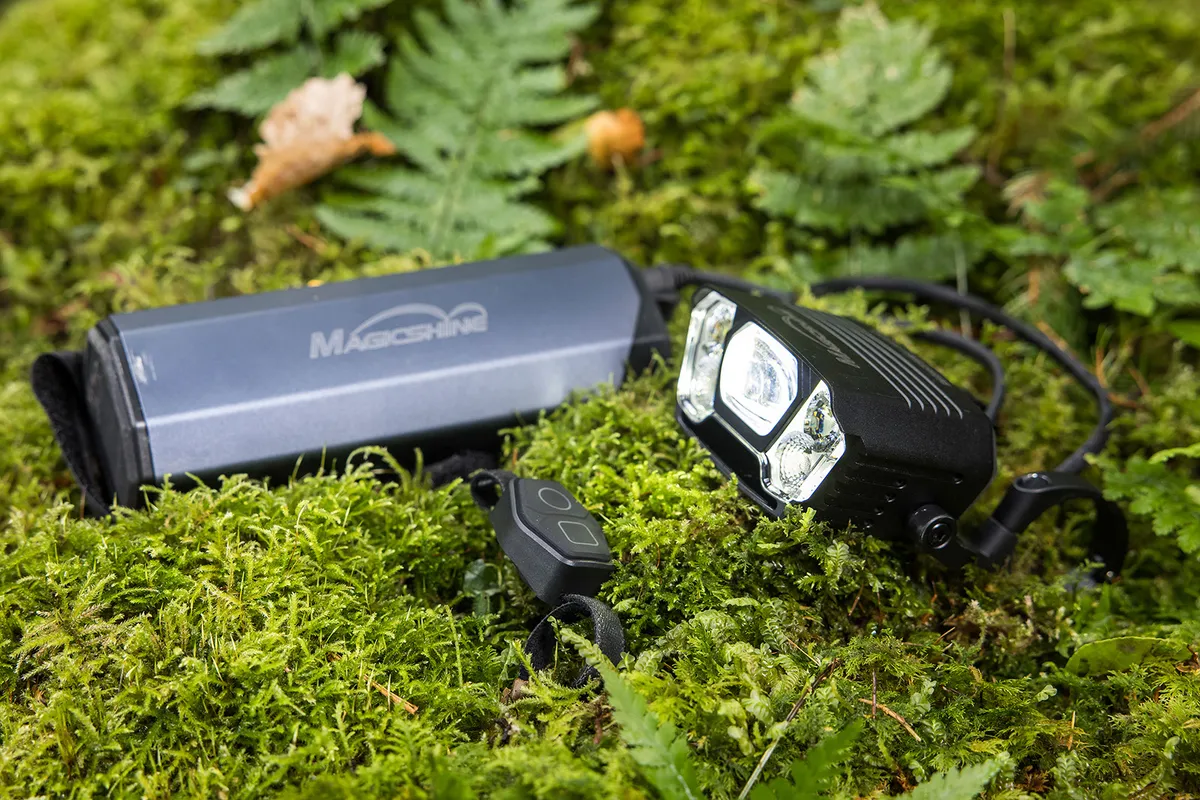
- £450 / $550 / €530 as tested
- Pros: Massive beam spread; immense power; easy to use
- Cons: Bar-mount width
With unrivalled power and a massive beam spread, the Monteer 12000 has the ability to turn night into day.
It lives up to Magicshine’s claims, pumping out an incredible amount of well-distributed light for brilliant trail context that boosts rider confidence sky-high.
Its throw is immense, and in Flood mode it illuminates the sides of the trail and around corners, too, in a soft hue that’s easy on the eyes.
Over two hours is a superb runtime for 12,000 lumens and lower modes extend battery life considerably while still projecting ample light.
The head unit and hefty 900g battery are impact-resistant and IPX6-rated, while the sturdy twin-clamp mount offers tool-free angle adjustment. A lid mount is included, too. There are charge indicators on the light, battery and Bluetooth remote.
- Read more: Magicshine Monteer 12000 review
Specs
Max lumens: 12,000 | Runtime (max power): 2 hours 30 minutes | Modes: 10 | Weight: 1258g
SQUIRREL_13076538
Magicshine Monteer 6500S Galaxy V2.0
SQUIRREL_TEXT_13123042

- £299 as tested
- Pros: Plenty of power for technical riding; yellow hue reduces harshness on eyes; solid construction
- Cons: On the heavier side
The Monteer 6500S Galaxy V2.0 uses five LEDs to cast an impressive 6,500 lumens on the trails.
We found the light to be more than effective at lighting up even the most technical trails under nightfall, with the yellow hue reducing strain on longer rides.
The construction of the Monteer impressed us, with its rugged design feeling dependable even on remote missions.
Its Garmin-style mount makes it quick and easy to fit, although it's still more laborious than lights with integrated batteries.
Specs
Max lumens: 6,500 | Runtime (max power): 2 hours 18 minutes | Modes: 3 | Weight: 554g
SQUIRREL_13123042
Blackburn Countdown 1600
SQUIRREL_TEXT_13077296
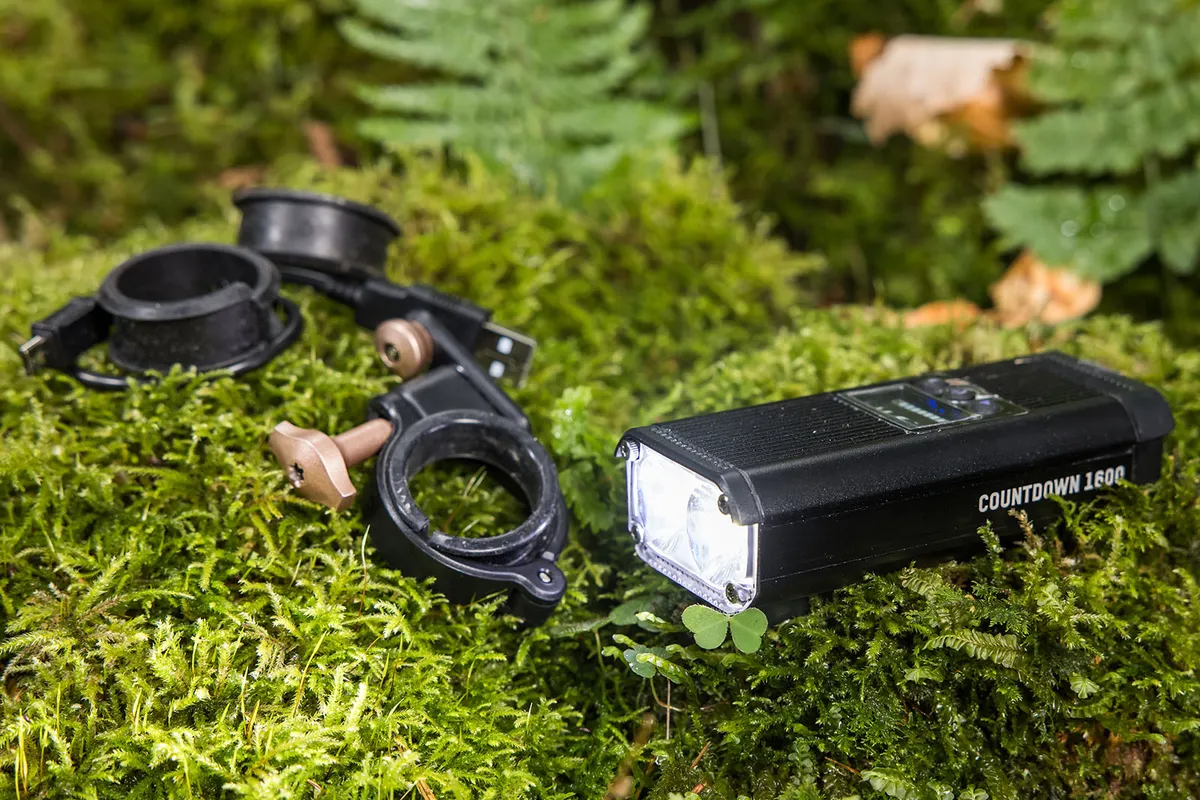
- £159.99 / $170 as tested
- Pros: Easy to use; good beam colour; plenty of power
- Cons: Beam spread limiting
Feeling much brighter than its claimed 1,600 lumens in Blitz mode and boasting an excellent IP67 rating, this is a great little all-in-one light.
It’s powerful enough for most black-graded trail-centre runs and the beam’s white hue with brown/red highlights illuminates trail surfaces while adding good depth.
The light has a long throw, making it easy to reach high speeds on straighter trails. Introduce tight switchbacks, however, and the lack of spread and stark peripheral cut-off limit speed and confidence.
While the interface between light and mount is good, the plastic clamp is hard to tighten, although its narrow width leaves space on the bar.
- Read more: Blackburn Countdown 1600 review
Specs
Max lumens: 1,600 | Runtime (max power): 1 hour 43 minutes | Modes: 5 | Weight: 554g
SQUIRREL_13077296
Exposure Diablo 15
SQUIRREL_TEXT_13438804

- £245 as tested
- Pros: Impressive power; eye-friendly beam; premium quality
- Cons: Bar mount isn't the most robust; lateral spread not the best
Exposure's Diablo 15 continues the brand’s benchmark reputation for strong performance at a high price.
Its three LEDs produce a wide spot beam with impressive forward throw, illuminating trail features early and supporting faster riding on demanding terrain.
Lateral spread is adequate but not exceptional, enabling you to trace the trail edge, but it's not as good as others on this list.
The beam hue strikes a strong balance between blue and yellow tones, giving excellent contrast while remaining easy on the eyes during longer rides.
Mounting is less convincing: the bar mount feels flimsier than its rivals, although the light’s low weight helps stability through bumps and compressions.
Specs
Max lumens: 2,000 | Runtime (max power): 1 hour | Modes: 7 | Weight: 127g
SQUIRREL_13438804
Lezyne Mega Drive 2400+
SQUIRREL_TEXT_13142421

- £180 as tested
- Pros: Good power; excellent beam balance; well-priced
- Cons: Mount could be better; mode selection not the easiest
The Lezyne Mega Drive 2400+ provides strong trail illumination, with a beam hue that highlights trail features clearly without causing undue eye strain.
The spread from its five LEDs is broader than most, with this wider coverage helping to brighten trail edges and improve visibility through corners.
It has an integrated battery within its aluminium body and mounts using a rubber-band clamp.
We found the mount a little less sturdy than others, but it did a good job of pointing the light down the trail.
Lezyne says the device is IPX67-rated, meaning it should hold up on wet rides.
The single button makes toggling modes a little tricky, but overall, the light is easy to use.
Specs
Max lumens: 2,400 | Runtime (max power): 2 hours 15 minutes | Modes: 8 | Weight: 328g
SQUIRREL_13142421
Also consider...
The following products scored below four out of five in our test, but are still worth considering.
Cat Eye AMPP 2200
SQUIRREL_TEXT_13434505

- £179.99 as tested
- Pros: Good brightness; well-balanced beam; good width and throw
- Cons: Hue feels fatiguing on longer rides
The CatEye AMPP 2200 delivers a claimed 2,200 lumens from a single LED, producing a bright and effective beam that gives a clear view of the trail.
Its pattern strikes a strong balance between width and throw, spreading light to trail edges and helping see around corners, while also casting useful reach ahead.
This combination enabled us to ride with more confidence and speed than with lower-powered units.
The beam taper is gradual rather than harsh, improving peripheral vision and overall ride feel.
Its very cool white hue creates crisp contrast that highlights roots, rocks and other features.
While excellent for definition, it can cause your eyes to feel fatigued on longer rides.
Specs
Max lumens: 2,200 | Runtime (max power): 1 hour | Modes: 6 | Weight: 228g
SQUIRREL_13434505
Silva Free 3000 L
SQUIRREL_TEXT_13214949

- £359.98 (including £34.99 mounting kit) as tested
- Pros: Impressive versatility; well-balanced hue avoids harsh contrasts; good beam distribution
- Cons: Not the most powerful; battery could be more stable when mounted
The Free 3000 L offers great versatility, with the light also being marketed to runners, skiers, campers and mountaineers.
We found the light to offer a practical amount of illumination, though we felt we couldn’t hit the trail with the same speed as with the more powerful lights in this list.
The beam is made up of a spotlight and a floodlight, providing plenty of scope for spotting trail features.
Specs
Max lumens: 3,000 | Runtime (max power): 2 hours 47 minutes | Modes: 3 | Weight: 482g
SQUIRREL_13214949
Blackburn Dayblazer 1500
SQUIRREL_TEXT_13090806

- £89.99 as tested
- Pros: Compact; good brightness; projects a strong beam down the trail
- Cons: Harsh hue, spot beam profile and stability make it less versatile off-road
The Blackburn Dayblazer 1500 is a compact aluminium-bodied light producing a claimed 1,500 lumens.
Its beam pattern contrasts strongly with wider-spread units, delivering a tight central spot that throws light far down the trail.
This makes it effective for highlighting what’s ahead, but peripheral illumination is limited, reducing context around corners and trail edges.
The sharp beam cut-off from its twin LEDs reinforces this focused character. Within its lit zone, detail visibility is excellent, but the very white hue produces the harshest light on test.
This enhances contrast but can lead to eye fatigue over longer rides.
The Dayblazer offers five modes — three steady and two flashing — controlled via a single top-mounted button that also acts as a battery indicator.
Mounting is handled by a simple rubber strap. While functional, it proved less secure and more fiddly than clamp or bolt-on options, especially across rougher terrain.
A bonus is that it’s IP67-rated, making it great for wet-weather use.
Specs
Max lumens: 1,500 | Runtime (max power): 2 hours | Modes: 5 | Weight: 139g
SQUIRREL_13090806
Knog Blinder X 2300 + 10,000mAh battery pack
SQUIRREL_TEXT_13438820

- £269.99 as tested
- Pros: Well-designed; good mount; comfortable hue; strong beam pattern
- Cons: Warmer light sacrifices contrast and makes it feel less powerful than its lumen rating suggests
The Knog Blinder X 2300 uses 12 yellow LEDs to produce a notably warm light.
This hue is gentle on the eyes and comfortable for long rides, but the warmer spectrum is absorbed more by dirt and foliage, reducing contrast and making it harder to pick out trail details at speed.
Despite a claimed 2,300 lumens, its output feels less intense than the figure suggests.
Even so, the beam pattern strikes a good balance between forward throw and side coverage, lighting a useful section of trail.
The bolt-tightened mount is secure, with an offset design that centres the light neatly ahead of the stem.
A robust aluminium body adds a premium feel, while the included remote makes mode switching straightforward.
With an IP67 rating, the Blinder is also dustproof and waterproof, adding extra confidence in rough conditions.
Spec
Max lumens: 2,300 | Runtime (max power): 2 hours | Modes: 7 | Weight: 436g
SQUIRREL_13438820
Ravemen XR6000
SQUIRREL_TEXT_13106886

- £389.99 as tested
- Pros: Reliable and robust; quality construction; impressive power
- Cons: Held back by thermal throttling; pricey
As you’d expect considering the price, the XR6000 is made using high-quality materials that give it a premium feel.
The bright 6,000-lumen beam lights up the trail effectively, enabling you to ride seriously technical trails in the moonlight.
Unfortunately, the XR6000 suffered from overheating, which caused the light to have a maximum power of 3,000 lumens.
This may be less of a problem in colder environments, although this thermal throttling is a big drawback.
Specs
Max lumens: 6,000 | Runtime (max power): 2 hours 1 minute | Modes: 9 | Weight: 590g
SQUIRREL_13106886
How we test mountain bike lights

We turn nocturnal when testing mountain bike lights, spending hours in the woods at night testing their real-world performance.
Beam power, distribution and hue are all assessed, along with the light's battery life, mounting and general usability.
We also consider value for money, with the most expensive or powerful light possibly not being the best overall and the cheapest not providing the best bang for your buck.
Every light in this list is at least worth considering, with our top recommendations decided by overall performance, functionality, usability and value for money.
Our pros and cons section enables you to identify specific needs you may have that might not apply to an overall score, such as versatility between sports.
This list is updated every time we review a mountain bike light with a worthy score and old lights are removed when they become unavailable from retailers.
Why you can trust BikeRadar
BikeRadar has been an authority on bikes and cycling tech since its inception in 2007, delivering the world’s best riding advice.
We have experts testing all types of bikes, parts, clothing and accessories, from road, mountain and gravel bikes to commuting, bikepacking and electric bikes.
Our reviews are always editorially independent – with no exceptions. Our reviewers comprehensively test all products in the real world, always reflecting on performance, value and the wider market when delivering their verdicts and review ratings.
We have more than 15,000 product reviews available at your fingertips, as well as expert buying, maintenance, training, skills, health and fitness advice.
Our annual Bike of the Year test is an industry benchmark and the BikeRadar team consists of some of the most experienced riders and testers in the business.
Mountain bike lights buyer's guide
What to look for in a mountain bike light
When considering which mountain bike light to buy, there are four things worth bearing in mind:
- Lumens
- Runtime
- Beam pattern
- Extras
A minimum of 1,500 lumens will provide enough light for well-lit riding. You can get away with less, but if you ride fast or on technical trails, more lumens is better than less.
Runtime can vary a great deal between lights and it's minimised the more power the LEDs are pumping out. We've listed the runtime for each of the lights in this list at maximum power.
Beam pattern refers to how light is dispersed across the trail, and it can be just as important as lumens when it comes to how well you can see.
Lights will often have either a spot or flood pattern. Spot patterns highlight details in front of you in great detail. Flood patterns disperse the light over a wider area and can give you a better sense of what's around you. Some lights use a mixture of both.
Do you need an extra-long cable for a battery pack? Are you looking to mount a light on multiple bikes? It's worth paying attention to the extras that come with a light to make sure it's suitable for your specific needs.
We've made sure to refer to these four points in the reviews of all the lights listed here.
Lumens
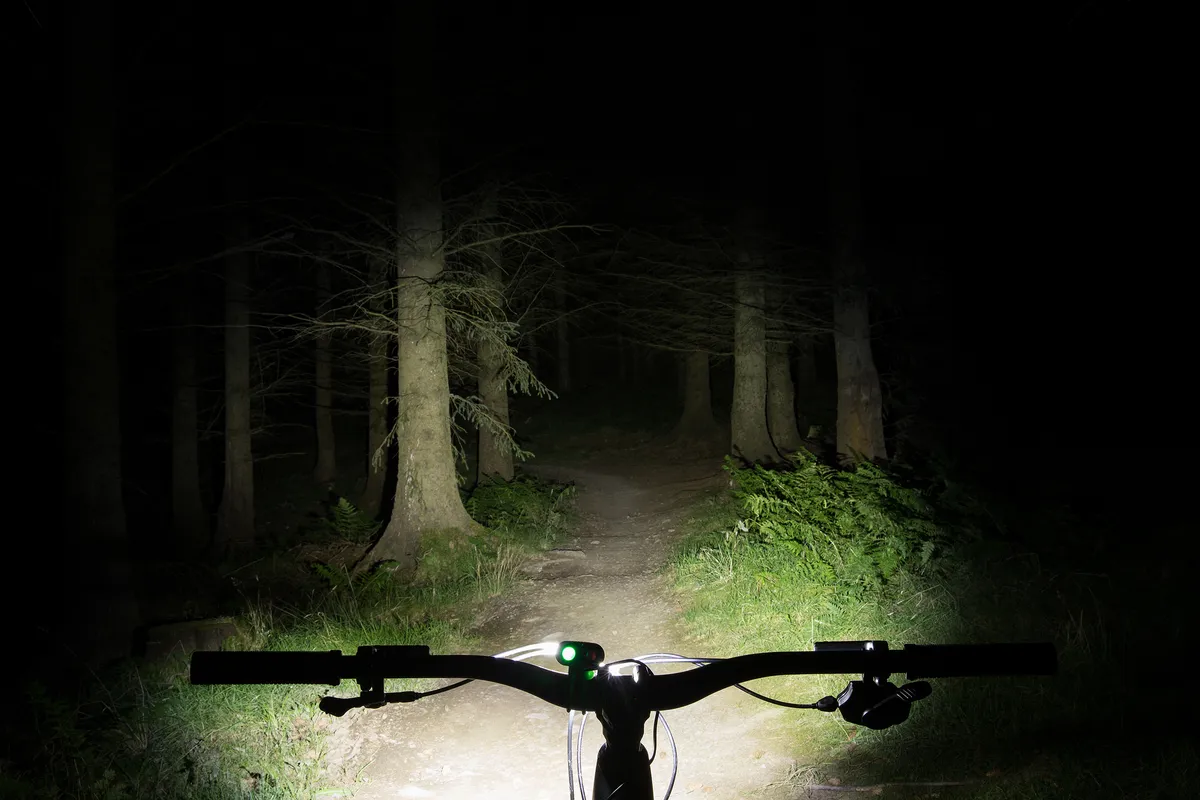
We set a lower limit of 1,500 claimed lumens when testing mountain bike lights, which is more than ample to provide safe and well-lit shredding. You could get away with less, but how suitable that is will depend entirely on how fast you want to go and how technical the trails are.
In the same way that claimed battery life, weight and a host of other things vary from their real-life measures, the number of lumens a manufacturer claims their light has, compared to how many it actually has, can vary significantly.
Don’t fret, though. While claimed lumens is a relatively important figure, what really matters is how that light is projected, not necessarily how bright it is.
Runtimes
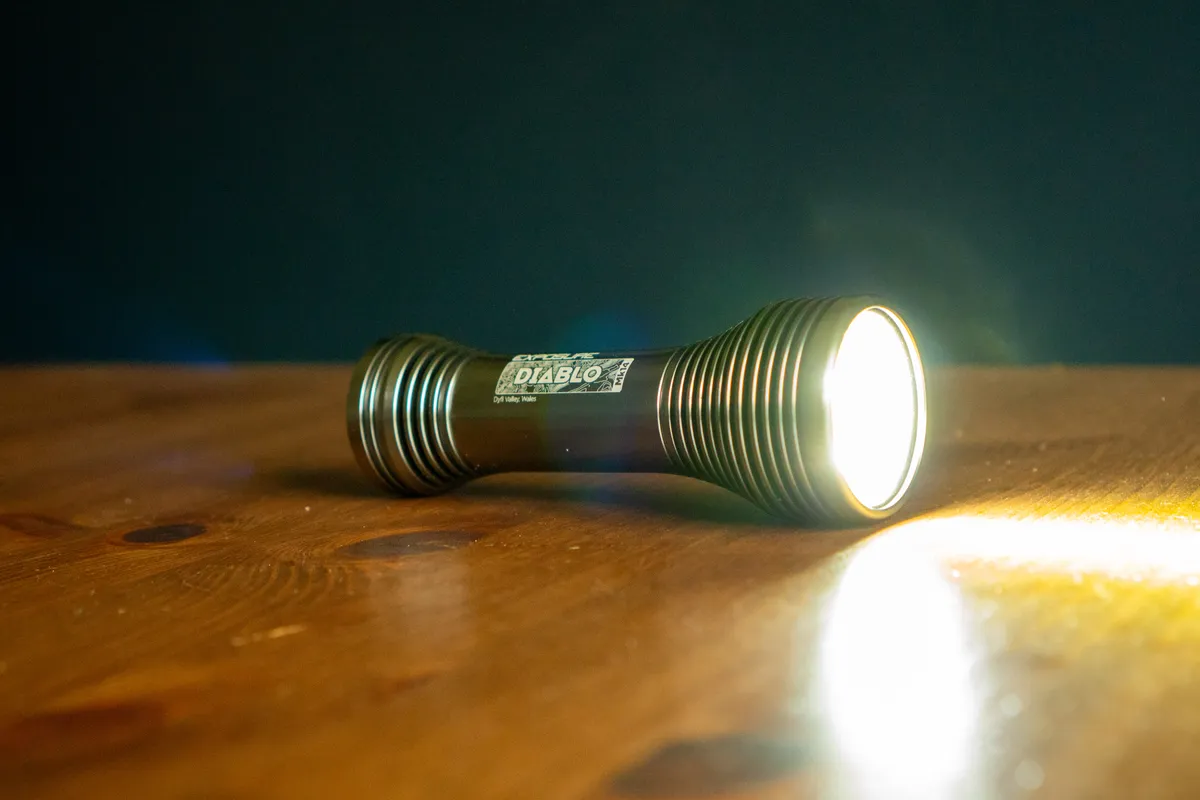
The same goes for runtimes. In our tests, we timed each of the lights on their maximum setting to find out just how long the juice will last.
If the LEDs push out lots of light, more battery power is required. All of our lights have at least one-hour of runtime at the 1,500-lumen minimum requirement, but most offer considerably more burn time at their maximum output, so it’s unlikely you’ll get caught short.
Battery and LED tech is improving all the time, and although lights with dedicated, separate battery packs will last longer than combined all-in-one units, the gap between the two is narrowing.
Beam pattern
Light output isn’t the only factor to consider – beam patterns are just as important. Some lights project their output into one specific area, illuminating everything within that space with exceptional detail, but that’s frequently at the expense of broader coverage.
Lights that flood their output illuminate more of the trail’s surroundings, giving a better sense of where you are and highlighting details easily missed with a more focused beam. This wider beam spread means it’s easier to see around turns, too – something that needs to be considered if you’re not running a dual-bar and lid-mounted setup.
Lights with multiple lenses or beam reflectors can combine spot and flood outputs, with the further option to toggle between them. In theory, lights with both beam patterns are the best of both worlds.
Extras
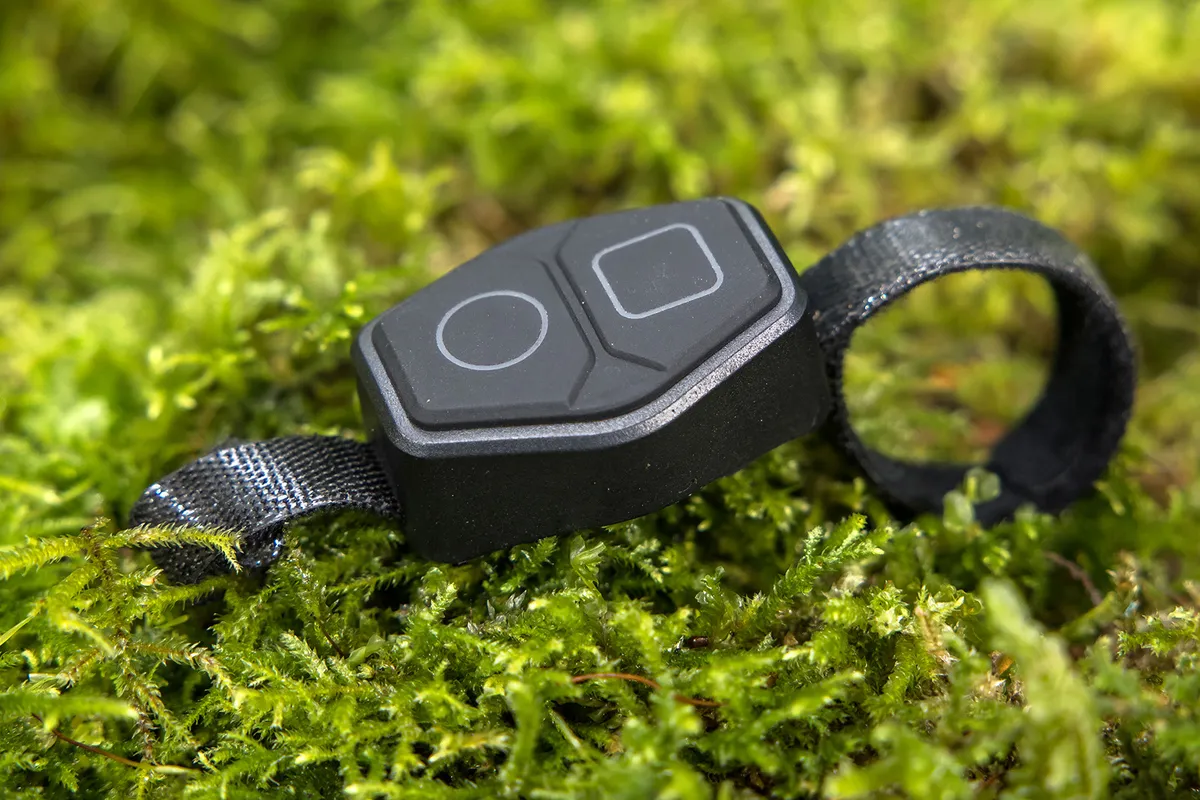
It’s also important to check out what extras are included with the light, such as remotes, extra-long cables to connect the battery and head unit, multiple mounting brackets, and whether they’ve got a certified waterproof rating, are shock-resistant and have battery or mode indicators.
The lights on test range widely in budget, from around £130 to north of £350. Although it’s possible to spend even more or a bit less, with a 1,500-lumen lower limit, this is the sort of price bracket you’re looking at unless you’re considering buying an eBay special.
Battery pack

On more powerful or longer-lasting lights, the battery pack is frequently separate from the LED section. They’re connected using a cable and the battery can be mounted to your frame or stem with Velcro straps or similar.
Bar mount
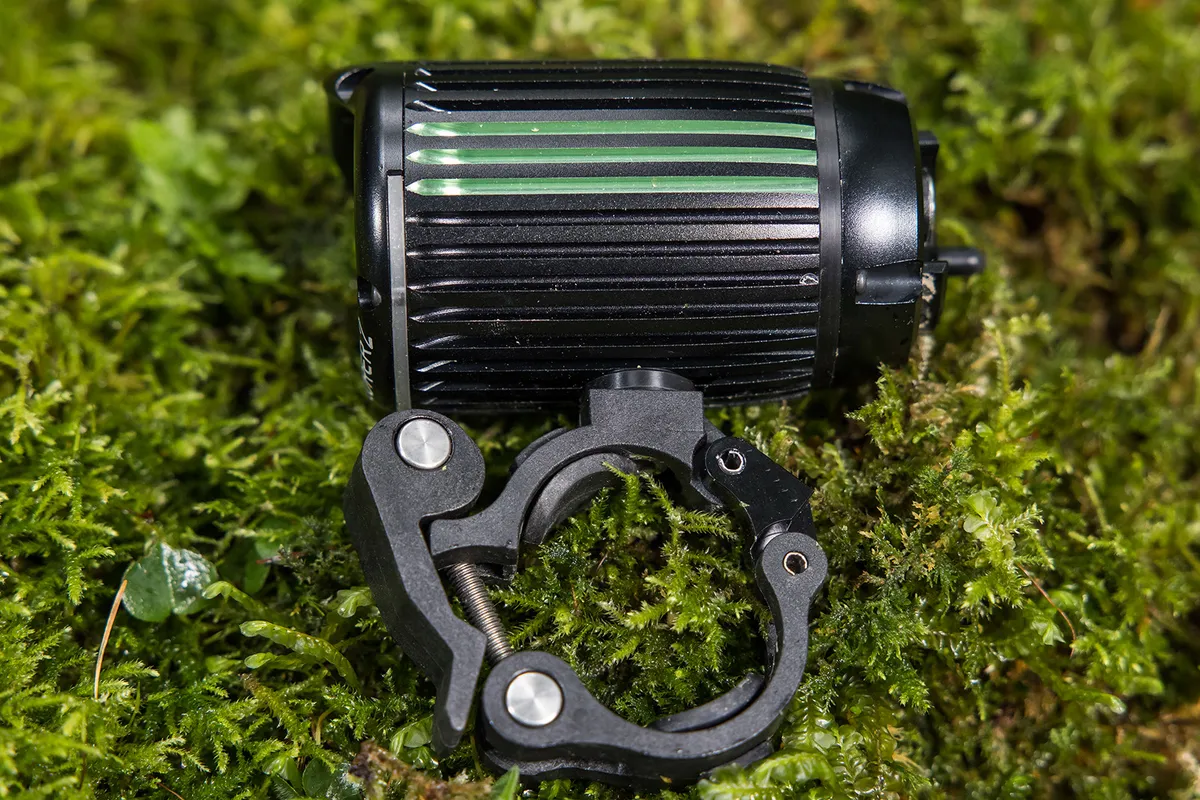
All of our lights on test are bar-mounted. Usually, the mount is tightened to the bar using an Allen key because head units can be quite heavy. Some lighter options use a rubber O-ring, while other systems have a bespoke ratchet strap system.
Lens
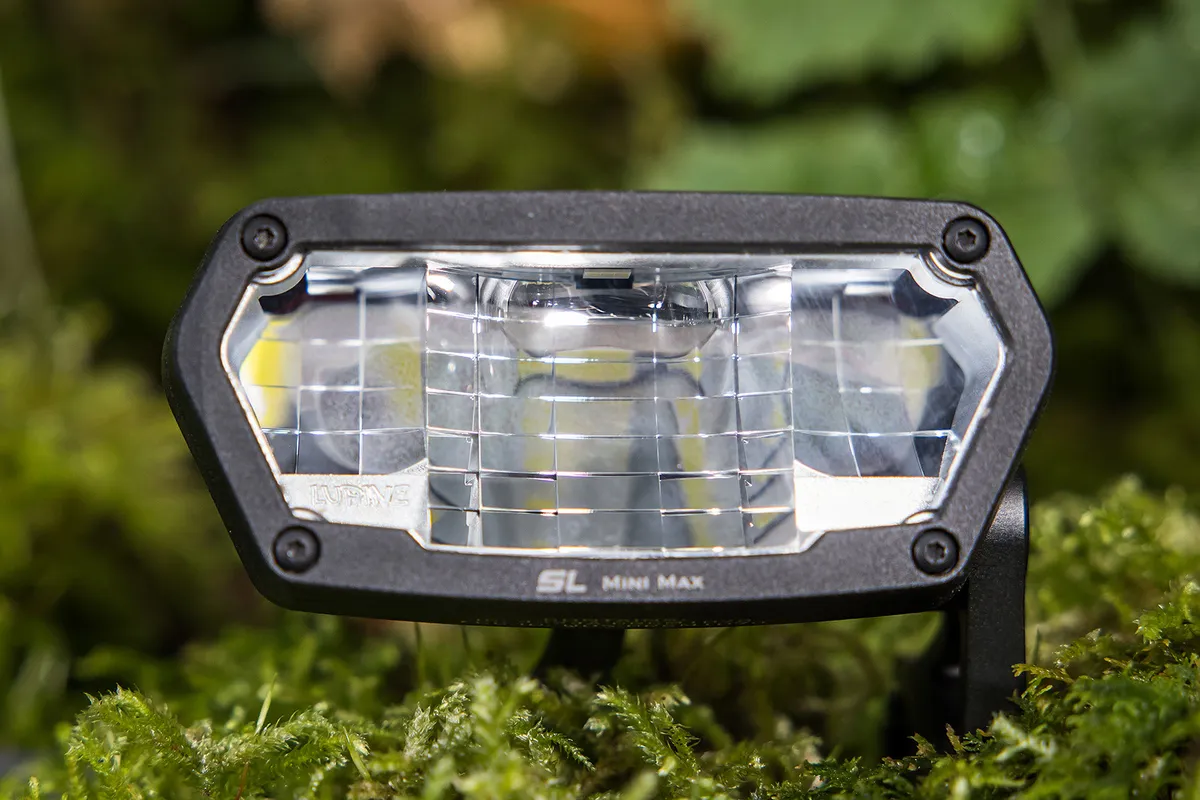
As the light from the LED and reflector shines through the lens, it’s either focused or spread depending on the characteristics of the lens. Lights with multiple lenses will give a greater range of beam patterns, illuminating the trail more.
Waterproof rating
It’s a fact – electronics and water aren’t best friends. While most light manufacturers have worked hard to avoid short circuits by waterproofing their lights, some have gone the extra mile and have been awarded an official IPXX (International Protection) rating.
The first number ranges from 0 to 6 (0 lowest, 6 highest) and denotes how dust-proof it is, the second is the waterproof rating ranging from 0 to 9 (0 lowest, 9 highest). If you’re being picky and are worried about the sorts of conditions you’re going to be riding in, pick a light with the highest rating. It's possible to have a dust rating and no waterproof rating – and vice versa.
Weight
With great power comes more weight. Generally speaking, if your light is putting out enough lumens to cast shadows during the day then it’s going to require more power to generate that brightness and last for any significant amount of time.
Bigger lithium-ion batteries are heavier and if the light is bar-mounted then this is something you’ll need to consider.
